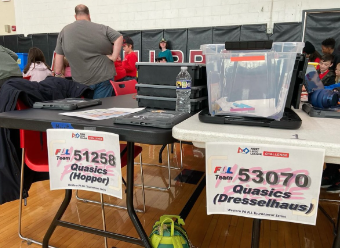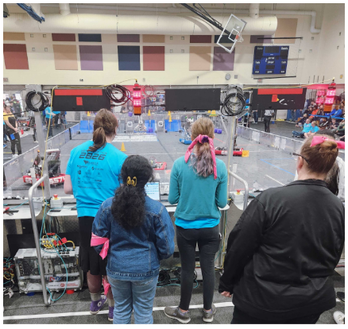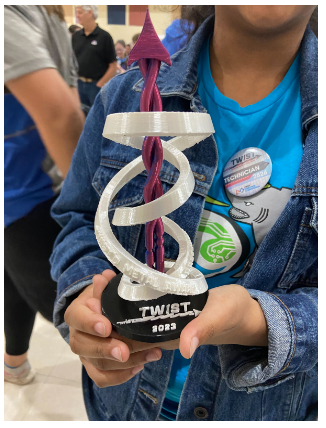|
Hello to FIRST Ladies blog readers, we are FRC team 1678 Citrus Circuits in Davis, CA!
Our Women in STEM Empowerment (WISE) initiative (explained in our last post) is dedicated to inspiring girls to take an interest in STEM. As computer science is becoming an increasingly important part of everyday life, we proposed a coding workshop as an extension to our WISE initiative, bringing an opportunity for students in our community to experience programming. We partnered with the local Da Vinci High School’s Computer Science Honors Society (CSHS) whose goal is to make computer science accessible to everyone and where a lot of the members are also part of Citrus Circuits. We targeted 3rd through 8th grade girls, who have either never done coding before or only experienced block coding. Through this, we hoped to introduce them to Python, a widely used programming language participants could apply to real-world use, and get a taste of programming in the career world. Student volunteers from CSHS and Citrus Circuits gathered to create a basic curriculum for children who had never experienced coding before. We faced a challenge, however, as we realized how complicated coding jargon can sound for elementary students. To address this concern, our volunteers worked diligently to explore how those concepts could be easily explained through continuous revision and feedback. On January 20th, 36 students eager to learn programming gathered in our local library, having the opportunity to meet fellow new programmers. Each volunteer sat at a table group, warmly welcoming the students. Laptops were graciously provided by the library to those who weren’t able to bring their own. As our main presenter led participants through the curriculum, students also had the opportunity to test the concepts they learned by having hands-on programming challenges, starting from how to print variables to creating conditional statements. Volunteers at each table group helped students one-on-one if any concepts confused them, as well as furthered their learning with more complex challenges. The finale of the workshop was a whole-group line-by-line input-based coding project. Hands shot up all over the room to participate in writing and debugging the code. Participants tested their skills by successfully creating a program that would ask people about their favorite food. As the students waved goodbye to the volunteers, we handed out certificates for completion of the workshop with helpful resources on the back for them to continue exploring computer science. It was a meaningful experience to host this workshop for girls in our community and collaborate with CSHS to organize a successful event. We hope it provided a great platform to introduce young girls to coding and inspire them to pursue future opportunities. The event also unlocked the potential of our partnership, encouraging us to envision future collaborative events and how our partnership might unfold to bring change to our community and beyond. - Written by FRC Team 1678 Citrus Circuits’ Diversity in STEM team
0 Comments
We are Reynoldsburg High School’s Technical Difficulties robotics team. Our team was created in 2011 and we have been exceeding expectations and growing ever since. Our team has faced many challenges and passed every obstacle in our path. We work every year to make our season better than our last, build our team closer and work harder in order to make our team better in every way. Each new season consists of many new members replacing old spots and filling in new ones. We have changed our subteam layouts and added/removed different groups or switched some duties around. As of right now, we have 7 main subteams; Mechanical, Electrical, Software, Business, Outreach, Media, and Design. We also have two other smaller subteams; Tactical and FabLab. Each of these groups has one or more leaders who split up certain tasks between themselves and their subteam members. Each subteam consists of a certain amount of members, typically ranging anywhere from two to sometimes six or seven--depending on the subteam. This season we have begun splitting up tasks more evenly between subteams and branching out to more specific assignments for each member. Along with this, all of our main leaders are students as well. This year we have two main managers, each with a different focal point of the team. We typically have about 50 members for the managers to guide and look after. Apart from the managers we have a few mentors and coaches to make sure everything is running smoothly, but other than that, the students do all of the work.
A lot of our team members, managers and mentors are also girls! We value a diverse STEM education on the team, which includes the women in our community. As a girl on 4085, I feel as if our team is inclusive in the best sense as there is no difference in how I am treated versus how a boy would be treated on the team. There are plenty of other girls that I interact with on the team. We are not viewed as solely girls, but as team members that have the same abilities as anyone else. Since there’s so many other girls on the team, I also feel as though there is a really great opportunity to make friends with other ladies in the school district. I’ve gotten to connect with more girls that are in different friend groups, different social scenarios than me, that I would not have got to meet otherwise. Other situations that I have been in the past that deal with engineering in robotics (classes, clubs, etc) have made me feel as though I don’t know as much as a boy. However, I have never felt that way with 4085. Whenever I ask questions, anybody who knows about the topic is allowed to speak up, not just a boy who appears “wiser.” I also have never been told any sexist comments about how I don’t know what anything is because of my gender. Although it is the bare minimum, it makes my experience on the team much more comfortable than any other one I’ve had. I also like how our team highlights the women on it. For example, we get many opportunities to speak up about how we feel on the team. We have surveys, we get opportunities to write blog posts such as these, and we get to speak about it in FIRST impact as well. 4085 highlights our ladies, and personally it makes me feel very loved.  Hello ladies in FIRST. I’m from FRC Team 2656, Quasics. I want to talk about the importance of FLL to our team. First of all, our team has two FLL teams: Team 53070 and Team 51258. We started FLL in 2020, and I’m going to tell you what I’ve found to be true. As a former FLL student, I’m first going to talk about the effect of FLL on the kids. I had zero interest in STEM before joining my FLL team, like none. I wasn’t opposed to the idea, I just didn’t take a liking to it. When I got the email about joining my school’s FLL team, I contemplated if it was something I wanted to do. I never really thought of robotics as a competitive thing, and I had to admit: it did sound intriguing. Like any teenager would do, I asked my friends if they were thinking about it. I found out that one of my friends was, and I decided to try it out. We had a few meetings over the Summer, and before I knew it, the game was out. There was something about finding an answer to a question that had never been answered before, that didn’t have a right or wrong answer, that kept a hold on me. This process, known by many as the engineering design process, changed my entire life trajectory. I started that summer without an interest in anything STEM related, and I came out of my eighth grade year wanting to pursue it as a career. Currently, I want to be a mechanical engineer, and I owe that all to robotics. Maybe not everyone has a story like this, but I am sure that everyone who does FLL takes away many skills. These include technical skills, public speaking skills, and most importantly teamwork. All of this can be achieved up to eleven years earlier than FRC! Alright, now that I’ve dumped my life story on you, let’s move on to the benefits FLL students and FRC teams get out of this. You may not realize it, but FLL actually does a great job at laying the foundational skills for FRC. In FLL Challenge, you get used to working with a team, building a bot and manipulators for a season-specific game, and presenting to judges. In addition to this, many FRC teams, including our own, run FLL teams. This means a smooth transition for FLL students and a sustainable flow of kids for the FRC team. Not every team member will necessarily join the high school team, but it has proved to be a pretty effective strategy for us. The last substantial benefit is the experience we get out of this. Currently, we have three FRC kids coaching the FLL students alongside our adult coaches. All of these student coaches have personally been through the FLL program, and this provides a unique perspective the adult coaches can’t provide. The FRC students are also taught how to lead, explain what they know to others, and teach younger kids. Because of all of this, I think FLL has been a great thing for us. Building better humans, one robot at a time, FRC Team 2656 Quasics Hi I’m Arcturus S and I am a part of Team 4085. I interviewed Ava R. Ava is the Central Project Manager of Technical Difficulties Team 4085.
Q: Why did you decide to join robotics? A: I started doing robotics at 5 years old as a part of my 4 h curriculum, it was an FLL team and just kind of sparked my interest in the program. I joined an FLL team in middle school because I really enjoyed it in 4h and it pipelined me into the Highschool team. Q: How has your time at robotics been defined? A: I would define my time in robotics as a time that has allowed me to improve my leadership and communications skills. I like to cooperate with people outside of the people I know. I have a lot of fun with my team as well as other teams at robotics competitions. Q: Do you enjoy robotics? A: I really enjoy robotics, it probably takes about 50% of my life and what I think about on a daily basis. Q: Would you suggest robotics to others? A: Definitely, I did a lot of recruiting this year to my friends. Approximately 100% of my friends are in robotics. Q: Do you think robotics has helped you to be a more successful person? A: I fully think so. I think it helped me with my time management skills and my communication skills. It has given me workforce skills such as writing emails and project management. Q: How has robotics impacted your experience as a woman in STEM? A: Robotics has really influenced some of the other academic things I have done and I feel empowered as a woman in STEM.I did a lot of robotics and STEM activities in 4 h and earned the clock award, the highest and most prestigious robotics award in 4 h.  Hi, readers of FIRST Ladies! My name is Dinah, and I have been doing robotics for almost four years. I am currently a member of the Marlbots 3526, a team of girls and other gender minorities based in Los Angeles, and this is my blog about the incredible Hedy Lamarr. I love all things STEM-related, don’t get me wrong, but perhaps more importantly, I love old movies; if you’re feeling fancy, you can call me a “cinephile,” but most of my friends prefer the term “film-bro”. Whatever I am, when I heard the story of Hedy Lamarr, two of my great loves fused, and I thought I would share her incredible story with you. Hedy Lamarr, born in 1913, was an Austrian-born Hollywood star during the early 20th century. After gaining fame in Europe by starring in films such as Geld auf der Strasse and Ecstasy, Lamarr escaped her overly possessive husband and came to the United States in 1937. In 1938, she appeared in Algiers, a classic romantic drama. From 1938 to 1945, Lamarr was under contract with the studio Metro-Goldwyn-Mayor and made a plethora of movies, some showcased her talent while most showcased her incredible beauty. In 1948, after unsuccessfully attempting to create her production company, Lamarr starred in Cecil B. Demille’s Samson & Delilah, returning to her classic femme-fatale aura. Lamarr eventually retired from acting in 1958. She did have a few public court appearances after being arrested and later cleared of shoplifting charges. She also sued the co-writers of her autobiography Ecstasy and Me for misrepresentation and sued the director Mel Brooks for including a character named Hedley Lamarr in his movie Blazing Saddles (1974). Although married a total of six times, Lamarr died alone in 2000. However, Lamarr was much more than a beautiful face with stunning dark hair on the shining silver screen. Although she invented several things that were never used, Lamarr wanted to create a device to help the Allies fight the Nazis during WWII, because of her Jewish relatives. Thus, Lamarr partnered with the composer George Antheil to find a method to steer torpedoes. During the war, torpedoes often missed their targets because German forces would jam the radio signals that steered the torpedoes. Lamarr and Antheil created a device that was similar to a piano: it included 88 different radio frequencies that the torpedo could randomly jump to prevent the Nazis from intercepting them. This method of radio-hopping called the "Secret Communications System” prevented Nazis from decoding Allied messages throughout the war. This later became an important part of developing the technology of cellular phones and military communications to ensure their security. Hedy Lamarr, although her scientific work often went unnoticed, was both an integral part of Hollywood and an integral part of modern technology. She is a key example of the layered role that STEM can play in our lives and demonstrates the enormous possibilities and potential of life in STEM. Just like Hedy, I can pursue my love for science and my love for movies at the same time. https://www.britannica.com/biography/Hedy-Lamarr “Hedy Lamarr | Biography, Movies, & Facts | Britannica.” Encyclopædia Britannica, 2023, www.britannica.com/biography/Hedy-Lamarr. Accessed 11 Dec. 2023. https://www.newscientist.com/people/hedy-lamarr/ Aron, Jacob. “Hedy Lamarr.” New Scientist, 2021, www.newscientist.com/people/hedy-lamarr/. Accessed 11 Dec. 2023. Hey FIRST Ladies community! My name is Emma, and I am a member of FRC Team 2656, Quasics. Our team is about 50% female and so is our Leadership Team. We are out of Gateway High School in Monroeville, PA. Quasics has been around since the 2008 season, and we currently have one FRC and two FLL teams.
Today I want to talk about our Girl Scouts program. We are program partners with Girl Scouts of Western PA, and we have been able to award 770 STEM badges and counting through this! During the year, we travel to troops near and far to run free workshops. Once a year in December, we run an in-house Badge Bash that brings in girls from several troops. Our kids often lead these events as young as Freshman. This is not only great for the girls, but it is a wonderful leadership opportunity for our students. The parents and troop leaders often compliment our students’ professionalism at these events, and the girls love having kids a bit older than them to look up to, especially our girls. So, how do we run these workshops? We write scripts and slideshows for these badges after looking over the requirements. It is super important that the girls meet all of the criteria to earn their badges. Sometimes this means completing handouts to plan out a game, learning about buoyancy by making a paddle boat, or discovering the effects energy has on motion with a balloon car. Whatever the workshop is about, we want to make sure the scouts have fun and learn about STEM. This part is extremely valuable, because this may be the first/last time the girls are introduced to STEM, and we want them to realize that science, technology, engineering, and math may be seemingly boring on their own but can come together into something extraordinary. The Girl Scouts setting is also a perfect place to show them that everyone has a place in STEM. Finally, how do we know this works? I mean, how can we really measure the impact that this is leaving. Well, I happen to be a former Girl Scout, and this girl’s first meeting with Quasics was in the recreational area of my school. That’s right, inspired girl to inspiring girls. In all seriousness, Girl Scouts is definitely my favorite kind of outreach, and I’m honored to be a part of these girls’ futures. Peace, love, and robots, FRC Team 2656 Quasics By the Marlbots 3526, a high school team of girls and other gender minorities based in Los Angeles, CA.
Contrary to the experience of many people in this world, Dr. Lee Mirsky did not grow up in a household dominated by specific gender roles. She is a sister to a younger brother, LGBTQ+ twins, and is married to a transgender man; her father worked from home, while her mother went to work at a hospital. When going to a McDonald’s drive through with her mother as a child, her family was asked if they would like a “boy toy” or “girl toy” with their happy meals. Instead of subscribing to such a binary and gender-specific tradition, her mother would play dumb, saying things like “I don't know what ‘girl toy’ or ‘boy toy’ is.” Dr. Mirsky was aware, of course, that other ways of living existed, but such occurrences were the norm in her family. Dr. Mirsky fell in love with science in an 11th grade physics class, encouraged from the help of a remarkable teacher at her school. From there, she went on to major in Physics and Environmental Analysis & Policy in college, but discovered her love of Materials Science (a combination of physics, chemistry and engineering) while at college. She decided to earn her PhD in Materials Science, and began to tutor physics throughout her graduate years, realizing her love of teaching physics. In 2016, during her last year in her PhD program, Dr. Mirsky joined the Marlborough School faculty part time to teach Physics, and in 2017, after receiving her PhD, she joined the faculty full time. At Marlborough, the high school robotics program was beginning to expand in such a way that the illustrious Mr. Witman required extra help, leading him to turn to Dr. Mirsky. At first, Dr. Mirsky was hesitant to join the program, but after going to a Robotics meet, she realized how much fun the Robotics world is. By 2018, Dr. Mirsky was Mr. Witman’s second hand; she was assisting after school, and also helped to teach the middle school Robotics classes, on top of teaching Physics. Although STEM is known as a fairly male-dominated field, Dr. Mirsky feels “very lucky” in that she’s been fortunate enough to have had positive experiences throughout her STEM career. Of course, like so many, she has dealt with inflated male egos: she once overheard a male peer discussing his “discovery”, which he had “discovered” in a research article that he simply modified. Nonetheless, Dr. Mirsky has never faced the typical disrespect so many women have faced in the STEM world at the hands of overzealous men. Dr. Mirsky attributes her positive experiences to great teachers, some luck, other areas of privilege that she has, but also her upbringing. Dr. Mirsky was never taught to actively see gender, and even in the face of obnoxious males during her school years, she never felt held back by her male peers. So, when asked about the difference between the number of male coaches and female coaches at Robotics meets, Dr. Mirsky said she never really noticed it until she began to think about it. It’s an interesting phenomenon - seeing gender is so ingrained in our society, but when a person is not taught to actively see gender roles, and constantly spend time and energy thinking about gender, their experience differs from the rest. Dr. Mirsky was never taught to see herself as overwhelmingly “female” in a STEM world dominated by “males,” and thus never felt the same effect of discrimination others are prone to. Dr. Mirsky is currently the “Engineering and Entrepreneurship Program Head” and “Associate Director of the Frank and Eileen Accelerator Program” and teaches AP Physics and Engineering and Invention for Impact at Marlborough School. With the increase of Dr. Mirsky’s responsibilities, she is no longer able to assist with Robotics, but greatly treasures her time with the teams. Hi FIRST Ladies community! Team Vertigo 18523 is proud to have partnered with FIRST Ladies for the 2023-2024 FTC robotics season. Relatively recently, two of Vertigo’s members worked on one of these blog posts, and we feel that we should give a background about us and our team
Vertigo is a Highland Park, Illinois community team founded in 2018. Currently, our team is 25% female. Our mission has been to spread our love for STEM and other robotics-related concepts to as many people as we can reach. We inspire the leaders of tomorrow by actively participating and volunteering in events. One example of this is that we have been volunteering at Boys and Girls Club (an after school program for underrepresented kids in a nearby community) for the past two years demonstrating that STEM can be interesting, cool, and fun for everyone. Ultimately, we believe that robotics is not just about building robots; it's about fostering a love for learning, collaboration, and innovation. Through our involvement in FIRST Ladies, we aim to continue inspiring and empowering young minds, particularly girls, to explore the wonders of science, technology, engineering, and mathematics. One of the most rewarding aspects of being part of the FIRST Ladies community is the opportunity to collaborate and share experiences with like-minded individuals who are passionate about robotics and STEM. We believe that by working together, we can create a more inclusive and supportive environment for everyone involved. Thank you for reading and for all those who have been making FIRST Ladies an incredible, positive community. Here's to a successful and fun rest of the robotics season! If you would like to follow our robotics journey, feel free to follow us on Instagram @vertigorobotics. Since 2018, we—FRC Team 1678, Citrus Circuits from Davis, California—have been hosting WiSE, or Women in STEM Empowerment events (more info can be found in the February 2023 newsletter and our website). Normally, these monthly events include stations of STEM experiments guided by female 1678 volunteers meant to engage girls 3rd through 8th grade and inspire them to take interest in STEM. However, to enliven our October event, we decided to make the activities Halloween themed. Additionally, unlike our typical WiSE event, which is done in the library, we decided the location this time to be the space outside our robotics classroom so that we were able to demonstrate our robot and show it in action to participants.
On the day of the event, our volunteers guided students through activities such as making structures of DNA using Q-tips and pipe cleaners. Our Halloween themed activities included making tissue paper ghosts fly through magnetism and building the tallest and most stable ghost tower using toothpicks and styrofoam balls. However, the most popular activity was making a screaming ghost balloon. Students, and even some curious parents, put a hex nut in a balloon and swirled it so that the friction between the hex nut and the balloon would create a “screaming” sound. We reached over 40 participants who came to not only enjoy these engaging activities, but also to watch our 2022 competition robot in action. Students had the opportunity to interact with it, feeding it cargo (oversized red and blue tennis balls) and catching the cargo it shoots. Our volunteers also answered questions regarding how the robot was built and what the game the robot played was, as well as general questions about our team. As the number of girls participating in our events increase every month, we hope that more young girls are inspired to take interest in STEM through WiSE and that our volunteers stand to be role models for them to join the vibrant FIRST community.
 Founded in 2008, 2826 Wave Robotics is a community team built for all. With 25% of students identified as female in the 2022-23 season, we hoped to increase this. To promote female engagement on our team, Wave has focused on female recruitment during the 2023 offseason. In the summer, our team designed a set of goals for the upcoming season. With an emphasis on rookie engagement and furthering student skill-sets, we focused on recruitment while ensuring all students were trained and ready for the 2024 Crescendo game. We began this journey by designing an offseason robot. Inspired by FRC team 1923 the MidKnight Inventors, we built a cube shooting robot. From concept to reality in less than two months, all team members were involved in this process. The programming team for this project consisted of 100% female students. Through this process, these students learned presets and autonomous coding, aiding a successful two cube auto.  In correspondence with this project, we designed extensive recruitment events throughout our community. As a community team reaching students across a 180+ square mile radius, it was crucial to a widespread plan, reaching students to our fullest abilities. By attending numerous markets, open houses, and camps, we were able to double the size of our team, with our team’s female percentage increasing by nearly 15% from the previous season. With new interest, our team knew we needed to engage these students through exciting events. We decided to attend the TWIST (Together Women in STEM Thrive) Offseason event hosted by FRC team 6421 WarriorBots. To prepare for this event, we created a one-on-one working environment. Our girls learned the essential pit skills and received a combined 30+ hours in drive-team practice and training.  On October 14th, we traveled to Muskego, Wisconsin to compete with 17 other teams. Beginning the day, we missed the practice matches as we were busy working to ensure our robot was ready for the day. We began our first match with a rocky start due to the RoboRio having connection issues with the FMS, leaving us unable to move. After working with the FTA we were diligently able to get this issue resolved. Throughout the day we were a competitive bot with a rotating drive team that proved to be successful. Going into the last quals match of the day, we unfortunately collided with the wall, resulting in our arm snapping in half. With this being the only mechanism on the robot, it was essential to fix this before playoffs. We worked diligently throughout lunch to put on a new fully functioning arm. Going into alliance selection, we were confident in our position as we were ranked 8th overall. We were the first pick of alliance 5 leaded by FRC team 6381 Red Raider Robotics and our partner FRC team 1732 #2 Hilltoppers. Moving into playoffs, we were confident of our abilities and tried our best. Unfortunately our alliance lost the first 2 matches. But the skills learned throughout the day proved to be more valuable. The judges awarded us the TWISTED Metals Award for our quick working robot repairs. Our girls learned the valuable skills of FIRST that will translate well for a successful season. We look forward to our next FIRST Ladies event, hosting a movie night playing Hidden Figures.
Wave Robotics’ Website: https://waverobotics.com/ |
Be a guest
Do you want to be a guest blogger for FIRST Ladies? You can write about a topic of your choice! Anyone can submit a blog, especially our Regional Partner teams! Please email us the a Google Doc of the completed blog. Thank you! Archives
April 2024
|


 RSS Feed
RSS Feed
